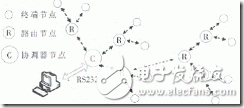Design of ZigBee Protocol Stack Software for Wireless Ad Hoc Network Node Hardware Design
The energy consumption of wireless ad hoc network nodes plays a crucial role in determining the overall lifespan of the network. ZigBee, based on the IEEE 802.15.4 protocol, is an emerging short-range wireless communication technology known for its low power and cost efficiency. In this system, routing nodes do not include sensor circuits, and due to their differing functions, the software drivers vary between node types. The coordinator’s software design encompasses device initialization, network formation, access from routing and sensor nodes, and data processing, including transmission and reception capabilities.
Currently, most monitoring and control systems rely on wired connections, which are prone to disruptions caused by corrosion or damage during installation and maintenance. This leads to operational issues and increases labor costs. To address these challenges, a wireless ad hoc network solution based on ZigBee technology is proposed, focusing on cost reduction and improved network stability.
ZigBee technology, built on the IEEE 802.15.4 standard, offers low power consumption, low cost, large network capacity, high reliability, and strong security. Sensor nodes equipped with ZigBee modules can efficiently coordinate multiple sensors and transfer data wirelessly through a relay-like process. This digital transmission technology is widely applied in industries such as agriculture, home automation, consumer electronics, and healthcare. It has become a key focus in China's "Twelfth Five-Year Plan" for information technology development. The paper covers hardware design of network nodes, implementation of ZigBee data transmission networks, and testing of wireless mesh networks. The system collects data at terminal nodes and routes it through multi-hop paths to the coordinator, enabling a robust wireless ad hoc network.
**1. System Network Structure**
The system network topology is illustrated in Figure 1, which uses a tree-based mesh structure. The network consists of three main functional components: Coordinator, Router, and End Device. This architecture ensures efficient data aggregation and reliable communication across multiple nodes.

**Figure 1: Network structure based on a tree-like wireless mesh topology**
circular connector,m series connector,m connector,m12 connector,m8 connector,circular connector m12,m8 electrical connector
Dongguan Yiyou Electronic Technology Co., Ltd. , https://www.dsubminiature.com